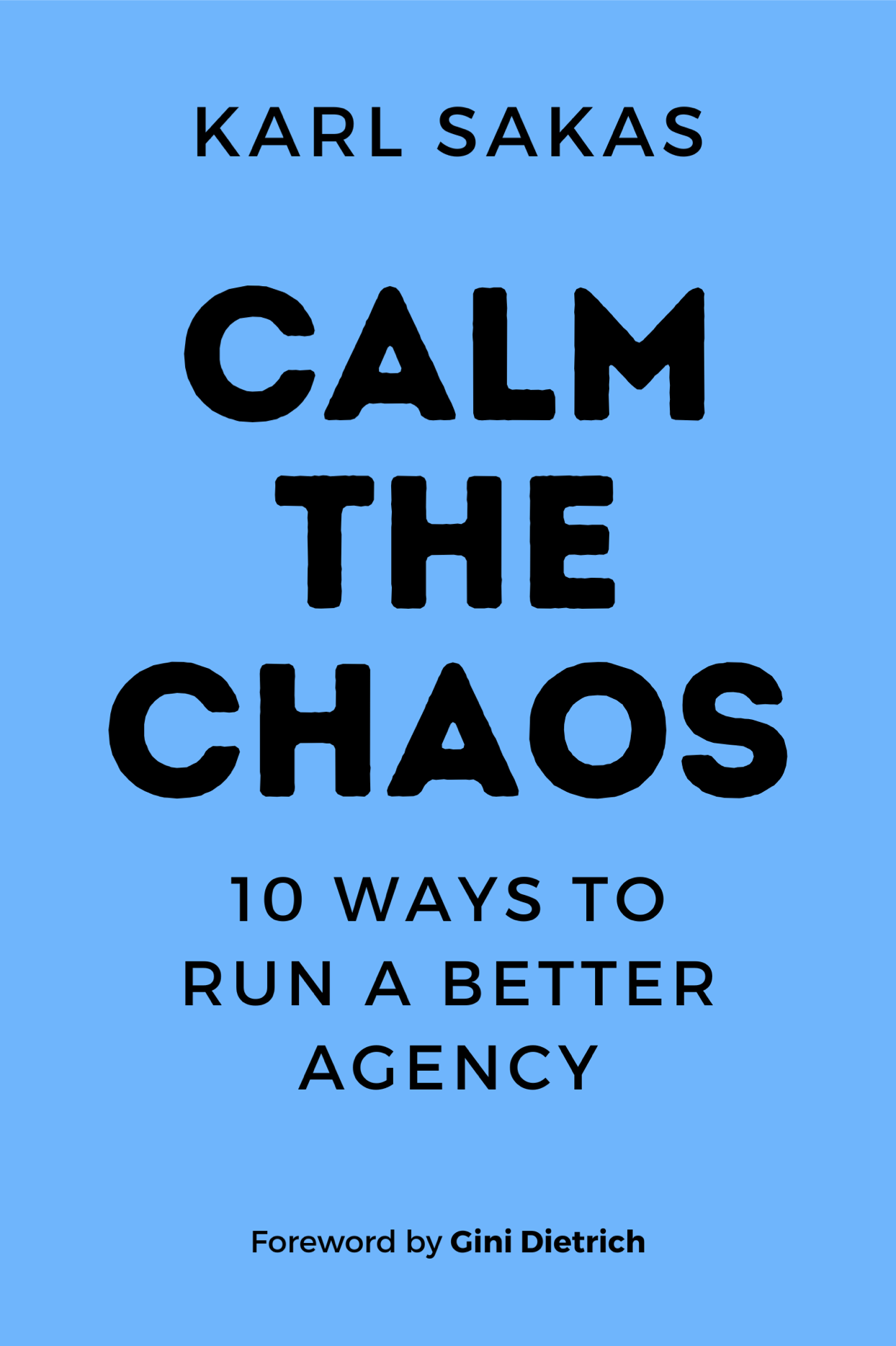What if three letters of the alphabet could help you prevent a big mistake at your agency?
As I shared last week, we’re susceptible to “get-there-itis” (aka “plan-continuation bias”).
Fortunately, there are some concrete things you can do to protect yourself… including the letters “O.B.E.”
Today, I’ll share 12 tips to help you avoid this common yet dangerous problem. To summarize:
- Add “Overcome by Events” (O.B.E.) to your agency’s internal vocabulary.
- Create an alternate Plan B up front, before you launch Plan A.
- Build fail-safe milestones into your initiatives.
- Be especially vigilant as you start and finish things.
- Get change orders for scope changes… even if it’s a “zero dollar” change order.
- Pause when a key person changes.
- Hold employees accountable to their new-hire ramp-up plan.
- Revisit your expenses when you see (or expect) a drop in revenue.
- Continuously eradicate “systems failures.”
- Take breaks to avoid short-term fatigue and long-term burnout.
- Solicit outside perspective on a regular basis.
- Stop to debrief if you succumb to plan-continuation bias.
Let’s take a closer look at each of those 12 tips, so you can choose the ones to apply next at your agency!
12 solutions: O.B.E., and other ways to save you from yourself
You likely won’t need to apply all of these at once. Instead, consider which will make the biggest impact… as well as which will be easiest to implement. (And discuss with your leadership team, since everyone has something to contribute.)
1) Add “Overcome by Events” (O.B.E.) to your agency’s internal vocabulary.
As I learned from my parents (both career Army officers), the military has a shorthand phrase designed to help people pause to regroup: “Overcome by Events” (aka “O.B.E.”—pronounced individually, as “oh-bee-ee”).
As soon as you realize something shifted, anyone can call out that the original plan is “O.B.E.” After that pause, you can decide what to do next—stop the project indefinitely, shift to Plan B, or something else. Speaking of alternatives…
2) Create an alternate Plan B up front, before you launch Plan A.
It’s easier to shift to an alternative solution when you’ve mapped-out alternatives in the first place. It’s harder to shift—and you’ll be more susceptible to plan-continuation bias—if Plan A was the only plan.
Your Plan B (and optional Plan C) might not be as in-depth as Plan A… but it’s easier later if they at least exist.
3) Build fail-safe milestones into your initiatives.
The idea is that you need to see certain things at certain points, or you’ll switch to Plan B. For example, consider my concept of new-hire ramp-up plans: if your agency’s new salesperson isn’t hitting their 2- or 3-month goals, they’re unlikely to be hitting their 12-month goals.
But be careful that you don’t over-couple things—the “if this, then that” should be reasonable rather than impossible.
4) Be especially vigilant as you start and finish things.
As I shared last week, the American Psychological Association (APA) notes: “Plan-continuation bias appears to be particularly strong toward the end of the activity…” In aviation, most accidents happen during takeoff and landing—so pilots are especially careful during those transition periods.
The same applies to your agency, albeit less life-and-death. Be careful as you draft the scope and (if applicable) finalize the Statement of Work (SOW). Even on an Agile basis, you still want to manage client expectations about what you will and won’t do.
Likewise, be careful as you complete a project or retainer. Consider allocating extra Quality Assurance (QA) budget during the final phases, when your team is at highest risk of delivering a “Friday afternoon car.”
5) Get change orders for scope changes… even if it’s a “zero dollar” change order.
When the scope changes, there’s technically a budget impact—that’s inherent to the Iron Triangle of Project Management.
Yet change orders are a hassle—they take time to write, and clients don’t always approve them… which delays the project either way.
It’s easy to say, “Oh, it’s small; we can skip the change order because it won’t make a difference.” As an agency PM, I tended to regret those shortcuts later. What seems small now might become huge later.
A streamlined option? Do a “zero dollar” change order. That is, you call-out the change as free… but you define the scope of what you will and won’t do. And, importantly, the client signs. (Since they’re paying $0, it tends to be easy to get a signature.)
If you opt to skip the change order, at least call-out (verbally and in writing) that things were “strategically free.” Otherwise, clients may expect similar freebies in the future… or may otherwise forget that it was a special deal.
6) Pause when a key person changes.
This is true whether they’re agency-side or client-side. Who’s a “key person”? I’d include:
- Client-side: Your team’s day-to-day contact, or their boss. Or the head of the entire department or division, if you were working lower-down in the organization.
- Agency-side: The account manager (AM), project manager (PM), or strategist (or systems architect, if it’s a technical project).
Pausing is especially important when someone’s left the company altogether. But I’d also consider pausing if they’ve gone on leave or have been reassigned elsewhere, since you’ve still lost the “institutional knowledge.”
7) Hold employees accountable to their new-hire ramp-up plan.
You created a new-hire ramp-up plan for a reason. If they aren’t keeping up, don’t give them a free pass… especially if they’ve missed one or more key milestones.
If they’ve slipped, tell them you expect a revised plan on how they’ll catch up. Then, evaluate whether their plan is reasonable… and hold them to it. You can’t afford to have Wet Twine employees on the team.
8) Revisit your expenses when you see (or expect) a drop in revenue.
This could include an actual drop in revenues (e.g., a current client wants to cancel early) or a projected drop in revenues (e.g., a “sure thing” client tells you they won’t be renewing for next year).
My recommendation? Define cost-cutting tiers during your budgeting process, so you can be strategic about budget cuts if you see (or expect) a drop in revenue. And if you didn’t do it before… now’s the time.
9) Continuously eradicate “systems failures.”
In my experience, most failures at agencies are systems failures. That is, an individual made a mistake… but it happened due to a series of mistakes.
As an agency leader, you’re responsible for heading-off systems failures. For examples and a mindset shift, read the excellent book Meltdown: Why Our Systems Fail and What We Can Do About It.
10) Solicit outside perspectives on a regular basis.
No matter how independent you are, there’s value to having someone ask you how things are going. They can offer accountability and external perspective.
As the client, I meet with my accountant quarterly, and with my financial planner 2-3 times a year. I speak with my coach each week, and with my therapist every other week.
As a manager, I do weekly One-on-One (O3) meetings with my direct reports. As an agency consultant, I meet with Executive Coaching clients monthly (or quarterly, in my new Targeted Coaching program).
11) Take breaks to avoid short-term fatigue and long-term burnout.
You may not be operating heavy machinery at your agency… but you still need unimpaired judgment as you run the business. This includes both short- and long-term breaks.
For instance, if I haven’t slept well—I don’t make big decisions the next day. I also avoid making big decisions at the end of the workweek, due to the “Friday afternoon car” effect.
Beyond short-term fatigue, you’re also at-risk for burnout. Take time away from work; otherwise you’re likely to make disengaged decisions that hurt your long-term progress.
12) Stop to debrief if you succumb to plan-continuation bias.
If you realize you made a mistake, that’s OK; it’s about how you respond next. I recommend a simple yet powerful three-question debrief:
- What worked?
- What didn’t work?
- What will we do differently next time?
The goal is to process what happened… but don’t dwell on what was “supposed” to happen.
Applying these tips at your agency
You don’t need to jump to apply all of these tips! Odds are you don’t need to do everything on the list… and certainly not everything immediately.
Instead, start by sharing this article (and last week’s on the concept of ‘get-there-itis’ at agencies) with your executive team. Ask each person to pick their “top 3” for your agency, so you can discuss at the next management team meeting.
Based on that discussion, prioritize where to focus next. This likely includes some high-impact long-term initiatives, as well as some quick wins. Good luck—and glad to help if you get stuck; you can contact me here.
Question: How will you use Overcome by Events (O.B.E.) and the other tools to prevent get-there-itis at your agency?
Image credit: “Storm is coming” by Aeroklub Praha Letňany is licensed under CC BY 2.0


